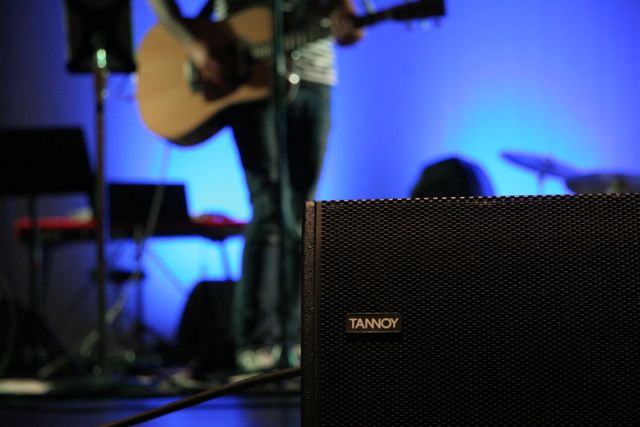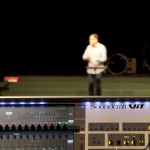AVL Design for Reality LA
[m-vslider id=”2″]
I’ve been delighted to work with the fine crew down at Reality LA (“RLA”) on the design and implementation of their new audio and lighting rigs, as well as improvements to their video capture rig as well.
BACKGROUND
Reality LA is a church plant of Reality Carpinteria. Tim Chaddick started praying about planting a church in the heart of Hollywood in 2004. January 2006 RLA launched its first Sunday morning service. RLA now packs out 3 services each Sunday at the Helen Bernstein High School. Brian Ortize is their music ministry pastor; he’s a talented man with an ear for tone and a heart for the Lord. RLA is blessed with a roster of pro touring and local session musicians to draw off. What ever you might think a Hollywood church might look like, let me tell you what I’ve been blessed to observe… The worship at RLA is unpretentious, beautiful and an authentic response to what God is doing in their community. FOH is located in the middle of the room, and so I’ve been treated to be able to mix in the middle of an engaged congregation as they worship their King. More about that later…
The Helen Bernstein High School courtyard is the tiered courtyard that you see on the TV drama GLEE. This school was masterfully built in an inner-city part of LA. The soft seat auditorium holds about 1000 folks, with theatre style diffusion panels from 8′ up and dense fiberglass absorption from 8′ to the floor. The room is quite tight from 200Hz up. The bottom end tends to ring out, and so we run a little light on the subs to keep things together.
RLA rents the facility, so everything needed to pack up and be kept in local storage. Kungpow Production was commissioned to build a system that could be setup by volunteers in 45 minutes, and stored in a room though a couple standard door ways. Nothing could be attached to the structure, which ruled out flying the PA, lighting or projection. In addition, we had to run the whole rig on the 20A Edison outlets available around the stage.
PA
When I got involved, the sound team lead by Brian Garcia was considering a ground stacked 8 box Nexo GEO S12/RS18 rig. Given the dimensions of the room, the limited stage thrust, and the fact that the rig had to be setup and torn down each week, the Nexo engineering team recommended that the church limit the rig to 2 GEO S12’s stacked in a horizontal array on 2 RS18’s per side. While this rig would have been a huge improvement over the Mackie SR1530’s, the team was concerned that the rig might not provide the kind of SPL they were out for.
Enter the Tannoy VQ NET60‘s. From the moment I first heard the VQ’s I knew I was in love. The VQs are a point source array. They’re terribly efficient, articulate and smooth in the vocal range, and punchy. We chose to run 2 VQNET 60’s, 2 VQ MB’s and 1 VNET 218DR per side, which is a lot of PA for a room this size. GC PRO masterfully sourced the gear, and let me tell you, everyone was impressed the day we lit the fuse on this rig. The PA run on available power. We’ve got all 4 tops on one 20A circuit per side. Each Sub runs on it’s own 20A circuit. Once I got the MB’s dialed in using the VNET software controller, I listened to a handful of my favorite songs at a range of volumes and eq’ed the boxes with the available parametric eq. This rig presents detail that I’ve only ever heard on audiophile systems. Later that afternoon, a handful of musicians and pro mix engineers ran the VQ’s through there paces. Everyone was impressed, some commented that the rig occurred like a mastering monitor system. Oh yeah and it can get scary loud.
CONSOLE
Four consoles were considered for this project: The Allen Heath iLive T112/iDR48, Digico SD9 & stage rack, Soundcraft Vi4 and the Avid Venue Profile. Since a number of the sound mixers made a living using Protools for film and television work, the Profile console emerged as an early front runner. I must admit, initially I protested selecting the Venue, mainly because I have had great experiences training volunteers on the iLive desk, and/or when a more sophisticated approach is needed I prefer the workflow of the Vistronic interface on the Soundcraft Vi series. The decision for the Venue was pretty much made when the Digico SD9 entered the fray. Perhaps using Waves plug-ins via Soundgrid would get the mix operators enough of the plug-in experience they knew so well… In the end after each approach was costed out, the support policies understood and factored in, and after collecting the opinions of a number of touring FOH mixers that the team knew, we decided to go with the Venue Profile system.
NOTABLE
Total Structures did some incredible work building custom rolling speaker carts for us. The Tannoys roll out of storage stacked and pre-wired. This configuration trimmed 30 minutes off the setup time and eliminated operator error when hooking up the PA.
The Radial Engineering Custom Shop built us four 8X4 sub-snakes that are pulled to each of the key positions on stage. The sub-snakes terminate with Veam connectors at the stage rack and keep the stage clean. It’s a clean system that goes together quickly and allows our volunteer teams to work in parallel to get our mics and powered monitors situated and cabled quickly.
Digigram ES220’swere implemented to carry audio to and from the video room over CAT5. The Digigram Ethersound system has worked flawlessly offering us a low-latency, reliable connection that eliminated the grounding issues we previously struggled with.
VIDEO
RLA uses a pair of Song PWMEX1s and a Newtek TriCaster 300 to archive the sermons for podcasts, and to send a feed to a cry-room. Kungpow was given the opportunity to consolidate their video production switcher, and we did just that. We racked the Tri-caster, added a SSD audio recorder and a AJA KAI PRO to capture the HD-SDI signal from the TRI-Caster. The whole system is pre-wired in a rolling rack that sets up in seconds, shaving another 30~45 minutes off the setup time.
LIGHTING
I love the fact that RLA has a focused strategy for lighting. The elect to use CYC lights and side lighting for the worship team. With no front wash, the musicians fade into the shadows on stage. It’s a great look, and an approach that’s very conducive to
clarifying that it’s not about the people on stage. We run a 8 Chauvet Colorado 1 Tours on stands, and 8 Colorado Batten 72‘s for the CYC. We’re using the Jands Vista software with an M1 console on a Mac to control the lights, and a couple W-DMX transceivers to get the DMX signal to the stage.


